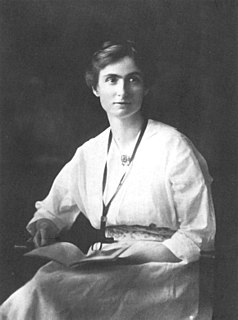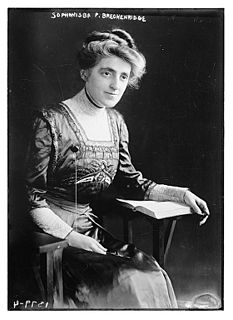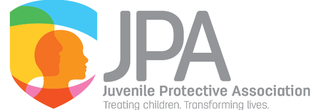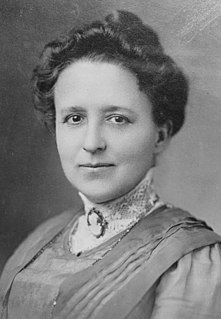
Jane Addams was an American settlement activist, reformer, social worker, sociologist, public administrator and author. She was an important leader in the history of social work and women's suffrage in the United States and advocated for world peace. She co-founded Chicago's Hull House, one of America's most famous settlement houses. In 1910, Addams was awarded an honorary master of arts degree from Yale University, becoming the first woman to receive an honorary degree from the school. In 1920, she was a co-founder of the American Civil Liberties Union (ACLU).

Hull House was a settlement house in Chicago, Illinois, United States that was co-founded in 1889 by Jane Addams and Ellen Gates Starr. Located on the Near West Side of the city, Hull House opened to serve recently arrived European immigrants. By 1911, Hull House had expanded to 13 buildings. In 1912 the Hull House complex was completed with the addition of a summer camp, the Bowen Country Club. With its innovative social, educational, and artistic programs, Hull House became the standard bearer for the movement that had grown nationally, by 1920, to almost 500 settlement houses.

Juvenile delinquency, also known as "juvenile offending", is the act of participating in unlawful behavior as a minor or individual younger than the statutory age of majority. For example, in the United States of America a juvenile delinquent is a person who is typically below 18 years of age and commits an act that otherwise would have been charged as a crime if they were an adult. Juvenile crimes can range from status offenses, to property crimes and violent crimes.

Edith Abbott was an American economist, statistician, social worker, educator, and author. Abbott was born in Grand Island, Nebraska. Abbott was a pioneer in the profession of social work with an educational background in economics. She was a leading activist in social reform with the ideals that humanitarianism needed to be embedded in education. Abbott was also in charge of implementing social work studies to the graduate level. Though she was met with resistance on her work with social reform at the University of Chicago, she ultimately was successful and was elected as the school's dean in 1924, making her the first female dean in the United States. Abbott was foremost an educator and saw her work as a combination of legal studies and humanitarian work which shows in her social security legislation. She is known as an economist who pursued implementing social work at the graduate level. Her younger sister was Grace Abbott.
Social work will never become a profession—except through the professional schools

Julia Clifford Lathrop was an American social reformer in the area of education, social policy, and children's welfare. As director of the United States Children's Bureau from 1912 to 1922, she was the first woman ever to head a United States federal bureau.

Sophonisba Preston Breckinridge was an American activist, Progressive Era social reformer, social scientist and innovator in higher education. She was the first woman to earn a Ph.D. in political science and economics then the J.D. at the University of Chicago, and she was the first woman to pass the Kentucky bar. In 1933, President Franklin D. Roosevelt sent her as a delegate to the 7th Pan-American Conference in Uruguay, making her the first woman to represent the U.S. government at an international conference. She led the process of creating the academic professional discipline and degree for social work.

The American juvenile justice system is the primary system used to handle minors who are convicted of criminal offenses. The system is composed of a federal and many separate state, territorial, and local jurisdictions, with states and the federal government sharing sovereign police power under the common authority of the United States Constitution. The juvenile justice system intervenes in delinquent behavior through police, court, and correctional involvement, with the goal of rehabilitation. Youth and their guardians can face a variety of consequences including probation, community service, youth court, youth incarceration and alternative schooling. The juvenile justice system, similar to the adult system, operates from a belief that intervening early in delinquent behavior will deter adolescents from engaging in criminal behavior as adults.
The child-saving movement emerged in the United States during the nineteenth century and influenced the development of the juvenile justice system. Child savers stressed the value of redemption and prevention through early identification of deviance and intervention in the form of education and training.
Chicago Area Project is a Juvenile delinquency prevention association based in Chicago, Illinois, United States. The association has been acting since early 20th century. The project was founded by Clifford R. Shaw. As of 2009, its current Executive Director is David E. Whittaker.
Child and adolescent psychiatry is a branch of psychiatry that focuses on the diagnosis, treatment, and prevention of mental disorders in children, adolescents, and their families. It investigates the biopsychosocial factors that influence the development and course of psychiatric disorders and treatment responses to various interventions. Child and adolescent psychiatrists primarily use psychotherapy and/or medication to treat mental disorders in the pediatric population.

Juvenile Protective Association (JPA) is a private non-profit agency devoted to protecting children from abuse and neglect by providing intervention and treatment services to families in Chicago.
This page is primarily concerned with juvenile delinquency in the United States. For information on juvenile delinquency in general, see juvenile delinquency. In addition, although the term juvenile delinquency often refers to juvenile as both the victims and the aggressors, this page only refers to juveniles as the actual delinquents. The information and statistics for juveniles as victims rather than offenders is much different. For information about juveniles as the victims of violent attacks, see trafficking of children, child abuse, child sexual abuse, or prostitution of children.
Richard Leos Jenkins was an American psychiatrist known for his work in child psychiatry and juvenile delinquency.

Mary Margaret Bartelme was a pioneering American judge and lawyer, particularly in the area of juvenile justice. She was the first woman appointed Cook County Public Guardian in Illinois in 1897, and the first woman elected judge in a court of high jurisdiction in the state in 1923. Earlier, appointed a judge assistant in 1913, she began hearing court cases involving juveniles and was referred to at that time as, "America's only woman judge", by The New York Times.

Lee Nelken Robins was an American professor of social science in psychiatry and a leader in psychiatric epidemiology research. She was affiliated with the Washington University in St. Louis for more than 50 years from 1954 until 2007.

Daniel Offer was a psychiatrist and scholar who challenged prevailing beliefs that adolescence is inherently a time of storm and stress. His Offer Longitudinal Study was one of the first studies of typical youth over time and demonstrated that most pass through adolescence adequately happy and connected to families and others. This contribution shifted fundamentally how adolescent development was understood scientifically and provoked recognition that theory from patient populations was inadequate. He is also remembered for his scholarship on normality, the viability of memory, the Offer Self Image Questionnaire and for fostering the field of adolescent developmental studies.
Jeanne Marybeth Spurlock was an American psychiatrist, professor and author. She served as the deputy medical director of the American Psychiatric Association for seventeen years. She chaired the Department of Psychiatry at Meharry Medical College starting in 1968, and she taught at George Washington University and Howard University. She also operated her own private psychiatry practice, and she published several works.
Child Guidance was both an evolving 20th-century social construct, sometimes called the Child Guidance Movement, and an influential network of multidisciplinary clinics set up to address the problems of childhood and adolescence. It began in the United States and after World War I spread rapidly to Europe, especially to England, though not to Scotland. It was the first child-centred institutional response to meet perceived child and youth behavioural and mental disorders. It therefore predated the advent of child psychiatry as a medical specialism and of distinct child psychiatric departments as part of modern hospital settings.

George Joseph Mohr was an American psychologist and psychoanalyst, specializing in pediatric psychiatry.
Donald Ernest Faulkner was a British colonial officer who the first Social Welfare Officer in a British colony in Africa. He was active in penal reforms for juvenile offenders and his office was involved in administering new legislation dealing with juvenile delinquency.











